|
Home | SchNEWS OF THE WORLD

Blue Stream in the Black Sea
The Black Sea and the region around it is one of the key areas
in the world for the transport of oil and gas, and it has paid the
price. NATO wouldn't have been as eager to bomb Yugoslavia, if there
was no pipeline through the Balkans. Russia may not have been as
ruthless in Chechnya, if the most important transfer route of Baku
oil didn't go through this small piece of land.
The Construction of a huge gas pipeline 2150m deep in a seismically
active (risk of earthquakes) area sounds pretty stupid but this
is exactly what's being built from Nadym-Pur-Tazovsko in Russia
to Ankara in Turkey. Oil and gas are obviously important enough
to take such a huge chance with the environment. The pipeline called
'Blue Stream' is a project of the Russian government and the formerly
state owned Gazprom, now a multinational with access rights to a
larger amount of natural resources than any other corporation on
the planet. Construction work on the 390 kilometre part of the pipeline
below sea level is being done by Saipem, a branch of Italian trans-national
ENI. The plan is to transfer some two billion cubic metres through
Blue Stream by the end of 2002, and up to 16 billion in 2007.
The original deadline of the project was the end of the year 2000,
but Gazprom has missed several deadlines already announcing different
reasons each time. The financial and infrastructure requirements
of the project are huge even for Gazprom who are on the brink of
financial collapse because of the huge fines it will have to pay
the Turkish government if the project misses its final deadline
in October 2002.
In the early 1980s an earthquake completely destroyed an undersea
cable in the Indokopas marine area as close as 30 kilometres away
from the proposed route for the pipeline. The Black Sea also has
a high concentration of hydrogen sulphide 150-200 metres below the
surface. According to the Russian state committee of environmental
specialists, it is possible that a leak would allow gas to combine
with the hydrogen sulphide at enormous pressure causing a huge explosion
and destroying much of the sensitive marine ecosystem.
During the summer of 2001, the folk of the city of Smolensk blockaded
the main road which Gazprom used in construction work twice. Police
were in the process of charging the people arrested at these blockades
with 'disobeying the police orders to disperse', when they tortured
one of them, Andrei Rudomaha, at the police station. This led to
those who had been arrested going on a hunger strike, and due to
wide pressure were eventually released without charges.
Between the 6th and the 15th of August grassroots
activists - mostly from the Rainbow Keepers network and Autonomous
Action - organised "a caravan of peace for a clean Black Sea".
They began from the point where the Blue Stream pipeline goes under
the Black Sea at Cherkesskoy Schel, finishing at the endpoint of
the CPC (Caspian Pipeline Consortium) oil pipeline in Yuzhnoe Ozereyka.
On September 20, four activists from the Socio-Ecological Union
of Western Caucasus, Autonomous Action and Rainbow Keepers movement
blocked the ship which was used to lay piping for Blue Stream. They
locked on to gangways in the middle of working area and dropped
a banner reading "No Blue Stream!" until being captured
Russian border guards. However because of attention from the media
and NGOs about the activists' arrests and the controversy of the
Blue Stream project, it was hushed up and they were also released
without charge.
www.potok.hotmail.ru (yes there's bits in English)

|



